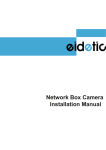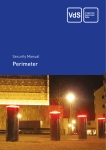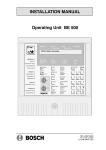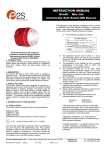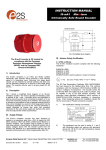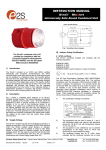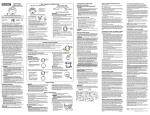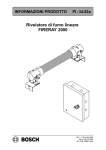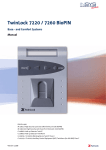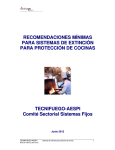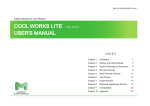Download Smoke Alarms Devices using Radio Links
Transcript
VdS Guidelines for Smoke Alarm Devices VdS 3515en Smoke Alarm Devices using Radio Links Requirements and Test Methods VdS 3515en : 2007-06 (01) Publisher and publishing house: VdS Schadenverhütung GmbH Amsterdamer Str. 172-174 50735 Köln, Germany Phone: +49 221 77 66 0; Fax: +49 221 77 66 341 Copyright by VdS Schadenverhütung GmbH. All rights reserved. VdS 3515en : 2007-06 (01) Smoke Alarm Devices using Radio Links Guidelines for Smoke Alarm Devices Smoke Alarm Devices using Radio Links Requirements and Test Methods Contents 1 1.1 1.2 General....................................................................................................... 4 Scope.......................................................................................................... 4 Validity ........................................................................................................ 4 2 Normative References.............................................................................. 4 3 Definitions ................................................................................................. 4 4 4.1 4.2 4.3 Requirements............................................................................................ 5 Radio transmission technology................................................................... 5 Power supply .............................................................................................. 8 Marking ....................................................................................................... 8 5 5.1 5.2 5.3 5.4 5.5 Tests........................................................................................................... 8 General ....................................................................................................... 8 Reproducibility ............................................................................................ 9 Environmental tests .................................................................................... 9 Variation in supply voltage of the radio module........................................ 10 Polarity reversal at the radio module ........................................................ 10 3 Smoke Alarm Devices using Radio Links 1 General 1.1 Scope VdS 3515en : 2007-06 (01) These Guidelines specify requirements, test methods and performance characteristics for wireless smoke alarm devices linkable by radio transmission using scattered light, transmitted light or ionisation, to be installed in residential houses, dwellings and rooms with residential-type use. Note: “Rooms with residential-type use” are, according to these Guidelines, “rooms resp. room groups of residential-type structure”. These include e.g. dwellings, residential houses, hotels, pensions or similar with less than 12 guest beds, container rooms, leisure accommodation or similar, social facilities such as kindergartens, schools for which there are no official regulations as regards automatic fire detection. Radio transmission to alarm systems or control and indicating equipment is not covered by these Guidelines. 1.2 Validity These Guidelines become effective upon publication. 2 Normative References These Guidelines incorporate, by dated or undated references, provisions from other publications (e.g. European standards EN or national standards DIN), as listed below. For dated references, subsequent amendments to or revisions of any of these publications apply to these Guidelines only when incorporated in them by amendment or revision. For undated references the latest edition of the publication referred to applies. DIN EN 14604 DIN 14676 3 Definitions The definitions used in these Guidelines are in accordance with EN 14604 : 2005 and as follows: Radio transmission technology Non-exclusive wireless data transmission technology using electromagnetic waves of a certain frequency range. SRD band Short Range Device band: radio band in which certain provisions apply regarding transmission performance, transmission time and applications. ISM band Industrial Scientific Medical band: bands available for industrial, scientific and medical applications for licence-free transmission. Certain provisions apply regarding transmission performance, interference, etc. 4 VdS 3515en : 2007-06 (01) 4 Smoke Alarm Devices using Radio Links Requirements For compliance with these Guidelines smoke alarm devices shall fulfil the following requirements: − relevant requirements of product standard EN 14604 − requirements of this Clause (evidence by visual inspection, engineering assessment or measurement). − requirements of the tests according to Clause 5 Requirements for wired linkable smoke alarm devices according to EN 14604 apply analogously for wireless linkable smoke alarm devices (including radio base or similar). 4.1 Radio transmission technology 4.1.1 Frequency bands 4.1.1.1 Requirement The high frequency components (transmitter and receiver) of smoke alarm devices with radio transmission technology should preferably operate in one of the two following frequency bands: − ISM band between (433,05 ... 434,79) MHz − SRD band between (868 ... 870) MHz Note: The use of other frequency bands is principally possible. In this case, additional resp. different requirements may apply. 4.1.1.2 Test method Verification of manufacturer’s specifications. 4.1.2 Transmission channels 4.1.2.1 Requirements Smoke alarm devices may communicate in several frequency bands resp. on several radio channels. A change of channel shall not cause any fault or alarm signals. 4.1.2.2 Test method The manufacturer provides an appropriate means to effect a change of channel. The state of linked smoke alarm devices is monitored during the change of channel. 4.1.3 Specifications of the frequency bands and channels 4.1.3.1 Requirement The specifications of the frequency bands and channels shall be complied with in each mode of operation as regards frequency accuracy, performances, duty cycle, etc. 5 Smoke Alarm Devices using Radio Links 4.1.3.2 VdS 3515en : 2007-06 (01) Test method Apart from a CE declaration of conformity the manufacturer submits a documentation clearly and comprehensibly illustrating that the requirements for each mode of operation (channels, operating states, etc.) are complied with. The required performance characteristics are theoretically checked against this documentation. (Alternatively a practical test may be carried out.) 4.1.4 Fault of radio link 4.1.4.1 Requirement If the radio transmission is faulty, this shall not impair the functioning of individual smoke alarm devices. 4.1.4.2 Test method Upon demand, the manufacturer provides an appropriate means to interrupt the radio transmission between the linked smoke alarm devices. The proper functioning of the individual smoke alarms is tested by releasing an alarm by means of aerosol. 4.1.5 Transmission time 4.1.5.1 Requirement The transmission of an alarm signal between two radio-linked smoke alarm devices shall occur within 30s. 4.1.5.2 Test method Two arbitrary radio-linked smoke alarm devices are commissioned. One of the smoke alarm devices is released. The time needed to release the other smoke alarm’s sounder is measured. The procedure is repeated 10 times. 4.1.6 Coding 4.1.6.1 Requirement Radio smoke alarm devices shall have at least six coding options. Only smoke alarms with dedicated coding may cause each other to go into alarm. 4.1.6.2 Test method The manufacturer submits a documentation clearly and comprehensibly specifying the functionality of the coding. The required performance characteristics are theoretically checked against this documentation. (Alternatively a practical test may be carried out.) 6 VdS 3515en : 2007-06 (01) Smoke Alarm Devices using Radio Links 4.1.7 Transmission of fault warning and status indicating signals 4.1.7.1 Purpose Radio smoke alarm devices may optionally be fitted with a device permitting the transmission of any fault warning and status indicating signals. However, a transmission of the “battery low signal” to the smoke alarm devices linked with each other, generated when the battery capacity drops, is mandatory. This facility shall e.g. ensure an early identification of malfunctions of smoke alarm devices installed in rarely frequented rooms. In this case the following requirements shall be fulfilled. 4.1.7.2 Requirement The requirements of 4.1.6 shall be fulfilled analogously for the fault warning and status indicating signal: Only smoke alarm devices with dedicated coding may cause each other to go into fault warning and status indicating condition. The dedicated audible signal at the receiving smoke alarm device shall be clearly distinguishable from an alarm signal and repeated once every 4h. The “battery low signal” shall at any rate be evaluated by the smoke alarm devices linked with each other. 4.1.7.3 Test method The test methods specified in 4.1.6 are applied analogously: The manufacturer submits a documentation clearly and comprehensibly specifying the functionality of the coding. Two arbitrary radio-linked smoke alarm devices are commissioned. At one of the smoke alarms a fault warning or status indicating signal is generated, at least the “battery low signal”. The repeat frequency of the audible signal emitted by the second smoke alarm device is measured. 7 Smoke Alarm Devices using Radio Links 4.2 Power supply 4.2.1 Supply from the same power source 4.2.1.1 Requirements VdS 3515en : 2007-06 (01) If the smoke alarm device and the radio module are supplied from the same power source, the relevant requirements of EN 14604 shall fully apply. 4.2.2 Supply from separate power sources 4.2.2.1 Requirement If the smoke alarm device and the radio module are supplied from separate power sources, the following shall apply: − For the power supply of the smoke alarm device the relevant requirements of EN 14604 apply. − For the power supply of the radio module the requirements of EN 14604 apply analogously. 4.3 Marking The radio module of a smokealarm device with detachable radio module shall be marked as follows: − model designation (type or number) − terminal designations, in case there is a likelihood of confusion 5 Tests 5.1 General The general test and connection requirements of EN 14604, Cl. 5.1 apply. Apart from the required specimen and data the manufacturer submits: a) a further specimen b) information in the form of a documentation: 8 − radio bands resp. frequencies used − a radiation pattern for transmitter and receiver for each radio band used − the transmission distance between two smoke alarm devices in the free field as can be covered at any rate (minimum free field distance). This value shall be specified in the user manual (operating instructions). VdS 3515en : 2007-06 (01) 5.2 Reproducibility 5.2.1 Transmission power 5.2.1.1 Test procedure Smoke Alarm Devices using Radio Links The transmission power of each specimen is determined in the most unfavourable transmission direction according to manufacturer’s specifications. This may be measured e.g. in an absorber room or in the free field. In the case of several possible frequency bands it is measured in the highest frequency band. The smoke alarm device with the lowest transmission power is identified and marked as “S1”. It will not be used for environmental tests resp. tests in accordance with EN 14604. 5.2.2 Receiver test 5.2.2.1 Test procedure In the frequency band used in 5.2.1.1 the receiving capacity of all specimens is tested under free field conditions. In this test smoke alarm device “S1” is used as transmitter. Its most unfavourable transmitting direction faces the receiver. Successively, all the other specimens are positioned at minimum free field distance to the transmitter according to manufacturer’s specifications, such that their least sensitive direction faces the transmitter. The transmitting smoke alarm device is made to release an alarm signal. 5.2.2.2 Requirement The minimum free field distance between transmitter and receiver according to manufacturer’s specifications shall be at least 100m. Each of the ready-to-receive smoke alarm devices shall receive the alarm signal of the transmitting smoke alarm device and generate an audible alarm signal within 30s. 5.3 Environmental tests 5.3.1 Test procedure The smoke alarm devices including their radio module are subjected to the environmental tests in accordance with EN 14604, Cl. 5.8 to 5.14. During the operational tests the smoke alarm devices including their radio modules are monitored. Following the environmental exposure the respective specimens are again tested according to 5.2.1.1. The smoke alarm device with the lowest transmission power is marked as “S2”. Subsequently, each specimen subjected to an environmental test shall again be subjected to the receiver test procedure according to 5.2.2.1. 9 Smoke Alarm Devices using Radio Links VdS 3515en : 2007-06 (01) Transmitter shall be the specimen with the lowest transmitting signal (“S1” or “S2”). If it is specimen “S2”, the receiver function of “S2” shall be tested using “S1” as transmitter. 5.3.2 Requirements Apart from the specific requirements of EN 14604 the following requirements apply: During the operational environmental tests the smoke alarm devices shall not generate nor transmit any alarm or fault signal. Following the endurance tests no alarm nor fault signal shall be generated or transmitted upon commissioning. During the test procedure according to 5.2.2.1 each of the ready-to-receive smoke alarm devices shall receive the alarm signal from the transmitting smoke alarm device and generate an audible alarm signal within 30s. 5.4 Variation in supply voltage of the radio module 5.4.1 Test procedure The radio module is supplied with the maximum supply voltage and then with the minimum supply voltage (battery warning). In each supply condition it is tested whether the specimen is able to bridge the minimum radio distance specified by the manufacturer at the most unfavourable orientation. For this purpose, the test procedure of 5.2.2.1 is applied. Transmitter is specimen “S1”. Subsequently, one radio transmission each is effected in the other direction and under the same conditions, i.e. specimen “S1” is the receiver. 5.4.2 Requirements In each supply condition the radio transmission of an alarm signal shall be successful in both directions. The ready-to-receive smoke alarm device shall receive the alarm signal of the transmitting smoke alarm device and generate an audible alarm signal within 30s. 5.5 Polarity reversal at the radio module 5.5.1 Test procedure If mechanically possible, the poles of replaceable batteries shall be reversed for 10s to 15s. If a mechanically permanent connection with wrong polarity is possible, this shall be kept up for 2h. Following the subsequent battery connection with correct polarity, a function test shall be carried out demonstrating that alarm signals can still be transmitted and received via radio signal. For this purpose, the test procedure of 5.2.2.1 is applied. Transmitter is specimen “S1”. 10 VdS 3515en : 2007-06 (01) Smoke Alarm Devices using Radio Links Subsequently, one radio transmission each is effected in the other direction and under the same conditions, i.e. specimen “S1” is the receiver. In the case of more than one battery this procedure shall be repeated with each possible combination of polarities. 5.5.2 Requirements After the polarity reversal the functioning of the transmitting smoke alarm device shall not be impaired. The radio transmission of an alarm signal shall be successful in both directions. The ready-to-receive smoke alarm device shall receive the alarm signal of the transmitting smoke alarm device and generate an audible alarm signal within 30s. 11











